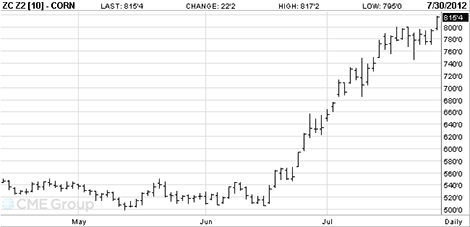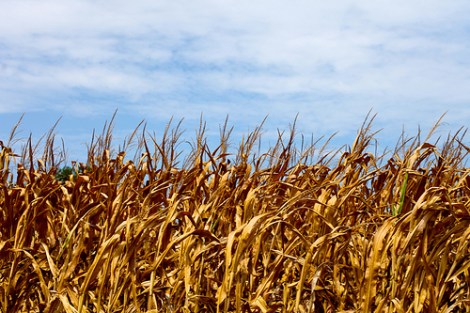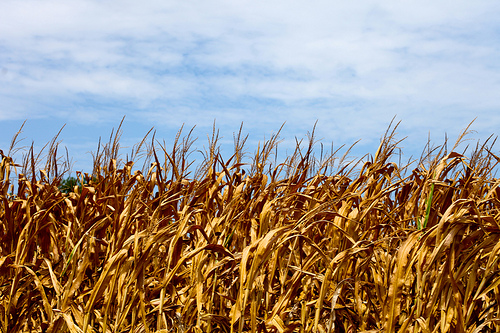This is what corn futures have done over the summer. I know it looks like the same graph we’ve shown you before, but it isn’t. The key difference is the number at the top right. It used to be a high of $7.50. Now corn is predicted to sell for more than $8.00 per bushel in December — an increase of 60 percent since spring.

Corn futures from CME Group. Click to embiggen.
The reason for the price spike, at the risk of sounding like a broken record: the drought. Less corn production, higher corn prices. We’ve noted that these price increases (and, in fact, expectations of higher prices) will impact other foods over the short- and long-term. But the meat industry is already feeling the pinch this summer — both because of concerns about corn prices and because animals have less of an appetite during a drought. Smithfield Foods is hedging against increased prices by importing corn from Brazil, a “highly unusual” step.
Politicians from meat-producing states are also banding together to try and increase the supply of corn for animals by challenging the amount of the grain that is used for ethanol. From Reuters:
At least one of four states hoping to ease requirements on adding grain-based ethanol to gasoline is expected to petition the [Environmental Protection Agency] as soon as Monday as the worst drought in 50 years spikes corn prices and lowers profits for livestock producers. …
The [Renewable Fuel Standard, or RFS] was signed into law by former President George W. Bush to help cut dependency on foreign oil by requiring that increasing amounts of ethanol be blended into gasoline each year. President Barack Obama has also embraced ethanol as part of his “all of the above” energy strategy.
But politicians in agricultural states that do not grow large amounts of corn worry the mandate raises the costs of animal feed for meat producers. About 40 percent of the corn crop is used to make ethanol, although distillers do recycle some byproducts to make animal feed.
If that 40-percent figure is reduced, more corn can be used for other things (like feeding animals) — increasing supply and dropping the price. The EPA, however, is unlikely to budge — meat producers have opposed the RFS since long before the start of the drought.

Photo by Tom Woodward.
Even if producers get more, cheaper corn for their animals, it’s possible that the animals won’t want to eat it. The impact of the drought is literally visible in animals being brought to state and county fairs. From Fox News:
The dozen pigs Greg Marzahl and his 15-year-old daughter are bringing to the Wisconsin State Fair are smaller than those he’d normally show. Marzahl, who had three grand champion pigs last year, said his pigs are around about 15 pounds smaller than the normal 275 pounds. The heat is affecting their virility and appetites, he said. …
David Laatsch, an agriculture agent with the University of Wisconsin Extension, said he’s judged several poultry contests for county fairs this summer and has seen fewer exhibitors and smaller animals. The heat also causes narrower and fewer feathers on poultry, he said.
Smaller animals mean less meat — and therefore higher prices.
We’ll close with some (sorta) good news about the drought: It could be worse. If this year’s drought isn’t sustained into next, it possibly won’t even have been the worst drought this century. The one that evaporated the western U.S. from 2000 to 2004 was determined to have been the worst drought in 800 years — since well before Europeans discovered the New World, or had even heard of corn.



